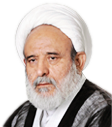In the Name of Allah, the Beneficent, the Merciful
All Praise belongs to Allah, the Lord of the worlds and the Maker of all creation, and may Peace and benedictions be upon His servant and messenger, His beloved and elect, our master, our prophet, and our sire, Abu al-Qasim Muhammad, may Allah bless him and his pure, immaculate, and infallible Progeny. I seek the refuge of Allah from the accursed Satan:
So for their breaking their compact We cursed them and made their hearts hard; they would pervert the words from their meanings, and they forgot a portion of what they were reminded of. (5:13)
We said that the event of 'Ashura' has been subject to tahrif and it has occurred both in its outward form as well as its inner content. A consequence of these distortions has been that this great historic document and this great educative source has become ineffectual or less potent, in our lives, leaving, at times, even an opposite effect. All of us have the duty to purge it of the distortions that have polluted this sacred document. Tonight we will discuss the general factors responsible for tahrif. Thereafter our discussion will focus on tahrif in the content and significance of this event.
These factors are of two kinds, one of which are of a general nature. That is, there are in general certain factors that lead to the corruption of histories and these are not limited to the event of 'Ashura' alone. For instance, the enemy's motives are themselves a factor that distort an event. In order to achieve their purposes, the enemies bring about alterations in historical texts or misinterpret them. There are many examples of it which I do not wish to mention here. All that I would say is that this kind of tahrif did play a role in distorting the facts of Karbala', and the enemies did take resort in misrepresenting the uprising of Imam Husayn. As usually happens, the enemies accuse sacred movements of causing conflict and division and of disrupting social harmony and peace. The Umayyad regime also made much effort to give such a hue to the Husayni uprising.
Such propaganda began from the very first day. When Muslim arrived in Kufah, Yazid, while sending an order appointing Ibn Ziyad to the governership of Kufah, wrote: "Muslim, son of 'Aqil, has gone to Kufah and his aim is to disrupt peace and to create social discord and disunity in the Muslim community. Go and suppress him." When Muslim was captured and brought to the dar al-imarah, the governor's residency, Ibn Ziyad said to Muslim: "Son of 'Aqil! What was it that brought you to this city? The people here lived in satisfaction and peace. You came and disrupted their peace, causing disunity and conflict amongst Muslims." Muslim answered in a manly manner and said: "Firstly, I did not come to this city on my own account. It was the people of this city who invited us. They wrote a great number of letters, which are in our possession. In those letters they wrote that your father, Ziyad, who ruled this city for years, had killed its virtuous men and imposed its scoundrels over the virtuous, subjecting them to various forms of tyranny and injustice. They appealed to us to help them establish justice. We have come to establish justice!"
The Umayyad regime did wage much propaganda of this kind, but their misrepresentations did not affect the history of Islam. You will not find a single competent historian in the world who might have said that Husayn ibn 'Ali, naudhubillah, made an unlawful uprising, that he rose to cause conflict and disunity among the people. No. The enemy could not bring about any misrepresentation in [the history of] the event of Karbala'. Most regrettably, whatever tahrif has occurred in the event of Karbala' has been at the hands of the friends.
The Second Factor:
The second factor is the human tendency towards myth-making and for turning facts into legends. This tendency has been at work in all the world's historical traditions. There is a tendency in men for hero worship which induces the people to fabricate myths and legends about national and religious heroes. 13 The best evidence of it are the legends that the people have invented around the figures of some geniuses such as Ibn Sina and Shaykh Baha'i. Ibn Sina, undoubtedly, was a genius and was gifted with extraordinary physical and intellectual powers. But these very gifts have led the people to weave out legends about him. For instance, it is said that once Ibn Sina saw a man from a distance of one parasang and remarked that the man was eating a bread made with oil. They asked him how could he know that the man was eating a bread and that it was made with oil. He replied that he saw flies circling the bread, which had made him conclude that there was oil in the bread. Obviously, this is a legend. Someone who can see flies from the distance of one parasang will see a bread made with oil much sooner than he would see flies!
Or it is said that once during the time that Ibn Sina was studying at Isfahan he complained that when he gets up in the middle of the night to study, he was disturbed by the noise of the hammering of the coppersmiths of Kashan. They went and made a test. One night they told the coppersmiths of Kashan not to use their hammers. That night, said Ibn Sina, he had slept peacefully and was undisturbed in his study. Obviously this is a legend.
Many such legends have been made about Shaykh Bahi'i as well. Such things are not confined to the event of 'Ashura. However, let the people say what they would about Ibn Sina. What harm does it do? None! But in respect of individuals who are guides of mankind and whose words and deeds and whose stands and uprisings serve as a model and authority, there should not be any tahrif whatsoever in their statements, in their personality, and history.
How many legends have been fabricated by us Shi'is about Amir al Mu'minin 'Ali, many Peace be upon him! There is no doubt that 'Ali ('a) was an extraordinary man. No one has doubts about 'Ali's courage which was superior to that of any ordinary human being. 'Ali did not encounter any contestant in battle without felling him to the ground. But does that satisfy the myth makers? Never! For instance, there is the legend about 'Ali's encounter with Marhab in the battle of Khaybar with all the curious details about the physique of Marhab. The historians have also written that 'Ali's sword cut him into two from the middle (I don't know whether the two halves were perfectly equal!). But here they found the opportunity to weave out fables which are harmful for the faith. It is said that God commanded Gabriel to go immediately to the earth lest 'Ali's sword when it comes down on Marhab should cut the earth into two halves, reaching right down to the Cow and the Fish. Gabriel was told to shield the blow with his wings. Gabriel went and when 'Ali struck the blow with his sword, it slashed Marhab into two halves which had they been put in a balance would have turned out to be exactly equal. However, one of Gabriel's wings suffered injury and he could not ascend to the heaven for forty days. When at last he arrived in heaven, God asked him as to where he had been all these days. He replied, "O Lord! I was on the earth. You had given me an assignment to go there." He was asked why he had taken so much time to return. Gabriel said, "O God, the blow of 'Ali's sword wounded my wings and I was busy bandaging and healing them all these forty days!" According to another legend 'Ali's sword flew so swiftly and slickly through Marhab's forehead cutting all the way to the saddle that when 'Ali pulled away his sword Marhab himself did not know what had happened (he thought the blow had gone amiss). He jeered at 'Ali, "Was that all of your swordsmanship?!" 'Ali' said to him, "Just move yourself a bit and see." As soon as Marhab made a movement, one half of his body fell on one side of the horse and the other on the other side!
Hajji Nuri, this great man, in his book Lu'lu wa marjan, while condemning the practice of fabricating of such legends, writes about legends that some people have put into circulation concerning the valour of Hadrat Abu al-Fadl al-'Abbas. According to one of them, in the Battle of Siffin (in which, basically, it is not known whether he had participated, and even if he did he must have been a boy of fifteen years) he threw a man into the air, then another, and so on up to eighty men, and by the time the last one was thrown up the first one had not yet reached the ground. Then when the first one came down, he cut him into two halves, then the second and so on to the last man!
A part of the interpolations in the narratives of the event of Karbala have resulted from the myth-making tendency. The Europeans assert that one finds many exaggerations in accounts pertaining to the history of the East, and there is some truth in what they say. Mulla Darbandi writes in his book Asrar al-shahadah that the cavalry of the army of 'Umar ibn Sa'd consisted of six hundred thousand horsemen and twenty million infantrymen - in all a force of one million and six hundred thousand plus all the people of Kufah! Now how large was Kufah? Kufah was a recently founded city and not more than thirty-five years old, as it was built during the time of 'Umar ibn Khattab. It was built at 'Umar's orders as a military outpost for Muslim warriors near the borders of Iran. It is not certain whether the entire population of Kufah during that time was even a hundred thousand. That a force of one million and six hundred thousand could have been assembled on that day and that Husayn ibn 'Ali' should have killed three hundred thousand of them is not at all reasonable. Such figures cast a shadow on the whole event.
It is said that someone once made exaggerated claims about the largeness of the city of Herat in former days. He said, 'Herat was a very big city at one time.' 'How big? he was asked. He said, 'At one time there were in Herat twenty thousand one-eyed cooks named Ahmad selling head and totters stew. Now imagine, how many men there must be in a city, and how many named Ahmad, and how many one-eyed Ahmads, to have twenty-one thousand one-eyed Ahmads selling head and totters stew!
This myth-making tendency has always been very active; but we must not leave a sacred document to the mercy of myth-makers.
There is amongst us, the Ahl al-Bayt, in every generation reformers who purge the faith of the perversions of the extremists, of the false beliefs of the falsifiers, and of the misinterpretations of the ignorant. 14
We have a duty here. Now let anyone say anything he likes about Herat. But is it right that such legends as these should find way into the history of the event of Ashura', an event concerning which our duty is to keep it alive and revive its memory every year?













